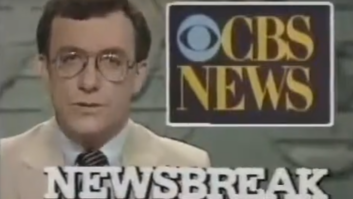Mike Frazier proudly relates what he hears from his contacts on the Benton Harbor, Mich., police force.
“A couple of thirty-something cops tell me one of the first things they do every morning is log onto our Web site. They say everyone else in the precinct does, too.”
That’s great news on two fronts for Frazier, the news director and content manager for Mid-West Family Broadcast Group’s WSJM(AM) in Benton Harbor.
First, it means people – in this case no less than the police department – are using the station’s Web site as a first source for information.
Second, he stresses the point that these are “thirty-something” officers, a sign that the Web site is helping attract a younger demographic to the news/talk station.
At first you don’t succeed …
The folks at WSJM will be the first to admit that this is a relatively new phenomenon.
“Until the middle of last summer, this was your typical radio site,” said Gayle Olson, president and general manager for WSJM Inc., the licensee for WSJM and Mid-West’s six other stations operating in southwest Michigan.
“There really wasn’t any reason to come back to it. It had bios of the personalities and a program schedule. Once you’d seen it, you’d seen it.”
But that changed on July 3, 2000, when the station relaunched its site, creating one of the most innovative radio news sites on the Internet.
When you log onto www.wsjm.com, local news literally is featured front and center. But not only can you read the news; in most cases you can hear audio clips and see visuals. Many of the stories are accompanied by still photos or short video clips, gathered by Frazier’s news team.
“The camera was the component we felt we needed to add to get people back to the site and keep them interested,” said Frazier. “We’re in a unique situation in this market in that there is no real television presence. We’re technically part of the South Bend, Ind., television market, but you rarely see a story about southwestern Michigan in a (TV) newscast, even though we’ve got over 200,000 people living in and around this area.”
Unusual market
Another opportunity was presented by the local newspaper, part of a disappearing breed of papers that publish in the afternoon. This means there is no news waiting on the doorstep when area residents wake up each morning.
“Our goal was two-fold,” explained Frazier. “First, we felt we could quench a visual thirst, and second we felt we could satisfy a thirst for morning news.
“If we could do our best to mirror what a morning newspaper looks like, and add the interactivity of the sound files and visuals, we felt we could achieve our goal.”
Based on traffic figures for the site, the station has tapped into something for which there is a demand. Between Dec. 20 and Jan. 18, WSJM.com attracted more than 3,500 unique visitors, with many repeated visitors to the site.
During this period, the site averaged nearly 7,000 hits per day, serving a daily average of more than 1,000 page views. Making this all the more impressive is Olson’s reference that “the entire cume for the radio station is around 10,000.”
The site has garnered national attention for its efforts. Shortly after its launch, it was featured in the Radio and Television News Directors Association publication, “Communicator.” Mark Thalhimer is director for the RTNDA Foundation’s “News in the Future Project.” He said this is an outstanding example of localizing the power of the Internet.
“In talking to people around the country who are trying to figure out what the relationship is between broadcast and online, so little is innovative at the local level. This is incredibly innovative, and it gets back to the whole idea that a journalist is a journalist and can inform people in a number of ways.”
Finally
Frazier first pitched the idea for adding visuals to a radio news Web site while he was working for news leader KFAB(AM) in Omaha, Neb., about a year ago, at the then-AM/FM station.
But the proposal never got far through the management hierarchy, and was derailed when Clear Channel bought the station last year and the news department was hit by staffing cuts.
Last June Frazier came on board at WSJM. Madison, Wis.,-based Mid-West Family Broadcast Group owns fewer than 20 stations nationwide. One of the first things Frazier did was dangle the Web site idea in front of Olson.
“There’s something to be said for a small chain of command,” said Frazier. “When I came here, it took about a week to get this done.”
With Olson’s approval, Frazier sat down with Dave Wolf, an overnight operations assistant who at the time also served as the station’s unofficial Webmaster. Frazier diagramed on a sheet of paper what he wanted the site to look like.
“Two days later Dave came back and had it done. We spent about another week tweaking it and then it was ready to go.”
But to really make the concept work required the buy-in of WSJM’s seven-person news staff. Frazier had to sell the radio reporters on the practice of carrying cameras with them on their assignments.
“The focus was to equip them with the tools they needed to provide more compelling content. They’re at meetings doing the interviews anyway. Snapping a picture is something they can do while they’re listening and recording what’s going on. It’s really no added time, it’s just making better use of the time.”
Personnel retainer
The news director said his staff was supportive and excited about the idea.
“The nice thing about being in small-market radio is that you’ve got kids who grew up with computers and they’re hungry and willing to do a variety of things in order to learn the business.
“One of the first things I did was sit down and explain our management vision on where journalism is going. We got on the same page that convergence is what’s happening and that they were going to be much more marketable professionally if they understood and embraced the technology. They were so excited about the idea that they actually fought over who got to use the cameras.”
Another important key to acceptance was making the additional responsibility easy on the news staff.
“My goal was to get the reporters to where they would spend no more than 15 to 20 minutes of additional time in their workday to add the content,” said Frazier.
The routine is efficient and fairly simple. On certain assignments, reporters take with them Sony Mavica digital cameras. The cameras have the capacity to capture on a disc 30 to 50 still pictures or up to 60 seconds of sound and video.
The reporters file their radio story at WSJM using AP NewsDesk and then paste it directly into the station’s Web site, along with the selected stills, sound clips and/or video.
In addition to work efficiencies, the site is also cost-efficient. Each of the Sony Mavicas (the station has three) list for around $700. The software package used for archiving stories, audio and video – Xcent’s XcNewsPlus – costs less than $100.
WSJM pays a monthly hosting fee to Quantum Connections, but has worked out a trade agreement with Quantum to reduce the fee. Olson made one staff addition, a new overnight operations assistant. This allowed Wolf to bring his talents to dayside, where he now devotes half his time to serve as official Webmaster.
Selling it
The site has yet to make any money, but that’s because the station only recently started to market advertising opportunities aggressively.
“We’re finding here and at some of our other company markets that it’s very hard for our radio sales staffs to sell the Internet,” said Joe Barron, Web developer for TRS New Media, the Internet division of WSJM Inc.
“It’s a different skill set. The size of orders is so different and it takes a different sales approach. We really had to wait until we could dedicate somebody to sell it and we just hired someone to do that.”
According to Barron, finding advertisers won’t be hard. “The advertisers have noticed this and they’re actually approaching us to be part of it. They’re finding it exciting that the same thing they listen to in the morning, now they can get online and get all that content.”
“There’s no doubt that there’s interest and awareness of the WSJM Web site among news-oriented advertisers,” said Olson. “I’m pretty confident that six months to a year from now we’ll have some significant income to show on the ledger.”










